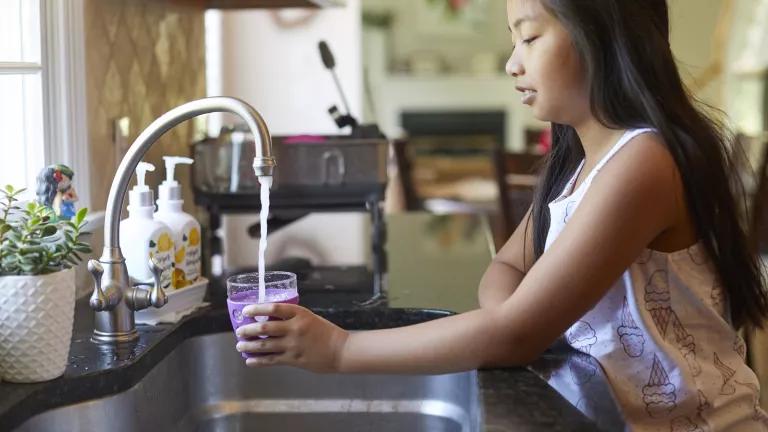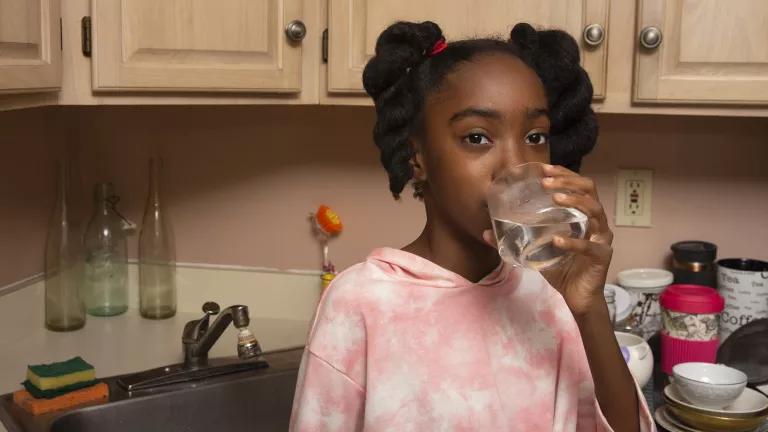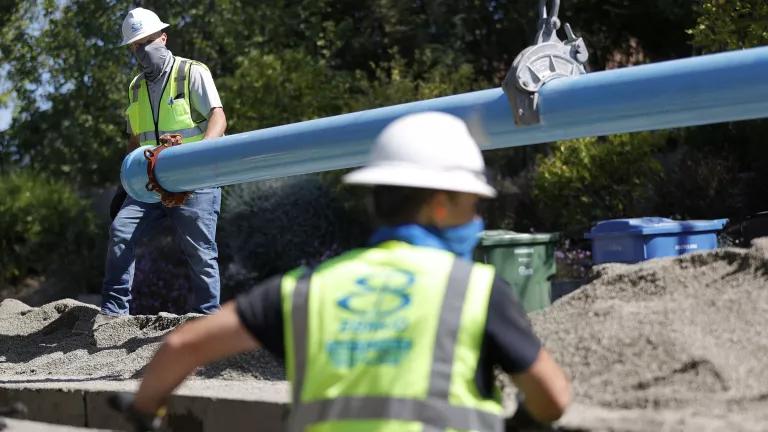Lead on Tap: A Short History of the Failure to Fix One of America’s Worst Water Contamination Crises
Why has it taken so long to fix the lead in tap water crisis? Here's a short history.
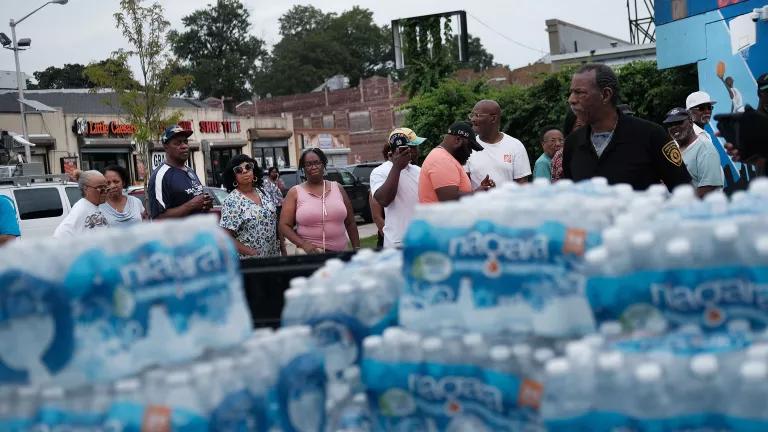
Residents of Newark, New Jersey, wait to pick up free cases of bottled water after high levels of lead were found in the local tap water.
Spencer Platt/Getty Images
The U.S. Environmental Protection Agency (EPA) Lead and Copper Rule Improvements proposal, to be released in November 2023, is the culmination of a struggle that has lasted nearly 50 years to get the agency to meaningfully tackle the nation’s widespread lead in drinking water crisis. What follows is a summary of the decades of weak EPA rules and congressional efforts to force action to address the problem of millions of people drinking water contaminated with lead, a potent toxin unsafe for human health at any level of exposure.
Early provisions of the Safe Drinking Water Act and 1991 Lead and Copper Rule
The Safe Drinking Water Act (SDWA), originally enacted nearly a half century ago in 1974, required the EPA to set interim drinking water standards within six months and then to promptly update them with final standards. In 1975, the EPA set a 50 parts per billion (ppb) interim Maximum Contaminant Level (MCL) for lead. More than a decade later, Congress was frustrated by the EPA’s inadequate “interim” standards and amended the SDWA in 1986. Those amendments required the EPA to quickly issue additional standards and ordered the agency to review the adequacy of health protection provided by its interim standards, including the lead rule, and to strengthen them if feasible. The 1986 law also prohibited the new installation or sale of lead pipes for use in drinking water.
In response, the EPA issued the now-infamous Lead and Copper Rule (LCR) in 1991 (the full rule as issued in 1991 can be found here; EPA’s summary as it has been revised over the years is here). The LCR was supposed to reduce the levels of lead in tap water, in part by requiring corrosion control treatment and the removal of some lead pipes that carry water from the water main in the street to homes called lead service lines. Removal of these lead pipes is only required when 10 percent of tested taps in a water system exceed the “lead action level” of 15 ppb. This EPA-invented action level is not an enforceable standard like an MCL. Rather, it is only supposed to trigger certain additional steps, such as improved corrosion control and removal of lead service lines, until the action level is no longer exceeded. In the same rule, the EPA also set an MCL goal of zero, acknowledging that there is no safe level of lead in drinking water.
In 1991, NRDC sued to challenge that rule as failing to adequately protect the public. The water utility trade association, the American Water Works Association (AWWA) also sued, challenging the rule as burdensome. The court mostly upheld the rule, though it told the EPA that it had failed to adequately address one of NRDC’s many concerns: the exemption of some noncommunity water systems (like motels, gas stations, restaurants, and parks that have their own water system). The court also went along with AWWA’s argument that the EPA did not provide the industry with sufficient opportunity to comment on its requirement to replace full lead service lines in some circumstances, including in cases where the utility controls but doesn’t fully own a lead pipe.
Responding to the court’s decision, the EPA later caved to AWWA’s pressure and issued a rule saying utilities only needed to pay for replacing the portion of lead service lines that they owned. The EPA made that decision even though these same utilities often required or encouraged and approved the use of lead pipes, frequently without the property owners’ knowledge. As a result of this fateful EPA decision, water utilities have only been required to conduct partial lead service line replacements, where they only replace the portion of a lead pipe that they own, even when lead levels at the taps they serve are extremely high. These partial lead service line replacements can increase lead levels for a time by dislodging lead particles from the remaining lead pipe and causing galvanic corrosion that can result when two different metals such as lead and copper touch (see my colleague Cyndi Roper’s excellent blog discussing the risks posed by partial replacements). Because of the weak LCR, AWWA’s pressure, and the agency’s regrettable decision allowing water utilities to dump much of the cost for lead service line removals on homeowners and landlords, few of these lead pipes have been fully replaced.
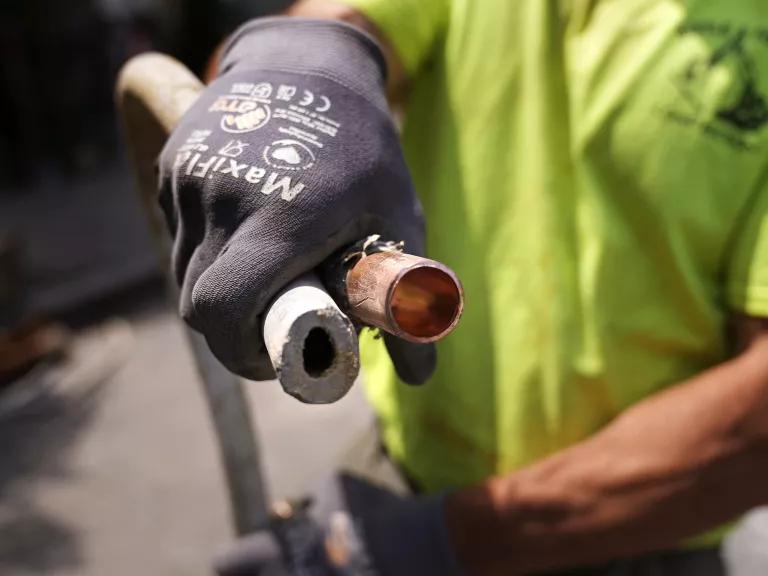
A worker shows the cross section of an original lead residential water service line (left), and the replacement copper line (right) outside a home in Providence, Rhode Island.
Charles Krupa/Associated Press
Lead crises highlight inadequate protection against lead, prompting congressional action
Congress has repeatedly updated the SDWA to tighten requirements for lead. The 1996 SDWA Amendments required new plumbing fittings and fixtures to comply with previously voluntary lead-leaching standards and prohibited sales of any of these items that failed to meet the law’s definition of “lead free.” In 2011, Congress passed another law that tightened the definition of “lead free,” lowering the maximum lead content of the wetted surfaces of pipes, fittings, and fixtures from 8 percent down to a weighted average of 0.25 percent.
Despite these laws, it became clear that the public was not being protected from lead in drinking water after numerous crises occurred, including in Washington, D.C., in the early 2000s and later in Flint, Michigan, and Newark, New Jersey. Even when there are supposedly no lead service lines, water that is inadequately treated for corrosion can cause serious lead contamination, as it does in Portland, Oregon, where it is an ongoing problem. As the EPA’s former head of enforcement has said, the LCR is difficult to enforce, and its implementation has long been “broken.” Indeed, NRDC’s analysis has found that tens of millions of Americans continue to be served by water systems that are significantly contaminated with lead, and according to the EPA’s latest estimate, 9.2 million homes are served by lead service lines.
In recognition of the continuing lead in drinking water problem, Congress again revised the SDWA in 2016, adding a grant program for the replacement of lead service lines, especially targeting disadvantaged households. Soon thereafter, seeing that this was still insufficient, and with strong support from the Biden administration, Congress amended the law yet again in the Bipartisan Infrastructure Law in 2021 to strengthen the lead service line replacement grant program and provide an unprecedented $15 billion exclusively for replacement of lead pipes.
Thus, Congress has repeatedly sought to strengthen protections of the public from lead in tap water, and specifically from lead pipes, but with only modest success—primarily due to the woefully inadequate LCR.
Recent history: Updating the Lead and Copper Rule
On January 15, 2021, in one of its last official actions, the Trump administration issued a revision to the LCR that would allow continued widespread use of lead service lines and lead contamination of tap water (summary of the Trump administration’s rule can be found here; the full rule text, here). The EPA asserted at the time that the rule would modestly increase lead service line replacements, though its analysis showed that most would remain in use. NRDC, the NAACP, frontline community groups represented by Earthjustice, and 10 states challenged what NRDC called the “weak and illegal” Trump administration rule. Ultimately, the EPA decided in December 2022 to no longer defend the Trump administration rule in court and promised a strengthened LCR by October 2024.
We hope that the EPA will at last meaningfully tackle the lead in drinking water problem when it finalizes an overhauled LCR in 2024. The health of tens of millions of people living in America depends on it.
Millions of Americans drink tap water served by toxic lead pipes.
Tell the EPA we need safe drinking water!
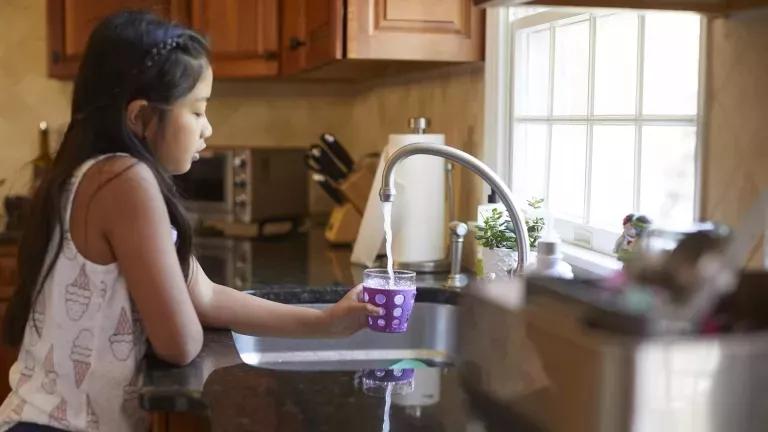
Tell the EPA we need safe drinking water!
There is no safe level of lead exposure. But millions of old lead pipes contaminate drinking water in homes in every state across the country. We need the EPA to do its part to replace lead pipes equitably and quickly.


